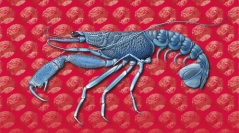

 Geodiversitas
45 (4) - Pages 139-161
Geodiversitas
45 (4) - Pages 139-161The Middle Jurassic (Callovian) fauna from Sainte-Scolasse-sur-Sarthe (Normandy, France) is remarkable for its exceptionally preserved crustaceans in arenaceous limestone beds. The crustacean fauna includes five species assigned to the Glypheidae, Erymidae and Longodromitidae. Glypheid lobsters are the most diversified and abundant group. A new detailed anatomic description leads to the first reconstruction of Glyphea dressieri Meyer in Bronn, 1837, and to highlight a marked sexual dimorphism. Similar observations are made in Glyphea regleyana (Desmarest, 1822). A quantitative analysis based on 149 specimens shows two dominant species: Glyphea regleyana (47.0 % of specimens) and G. dressieri (46.3 %). The palaeoenvironment is interpreted as subtidal mud flats largely open to offshore conditions. More precisely, the sedimentary facies and the associated fauna are indicators of a distal platform setting (upper circalittoral zone). The Sainte-Scolasse fauna is relatively close to that of the Oxfordian of Haute-Saône (eastern France) and thus forms an intermediate assemblage between the communities from the shallow carbonate platforms (e.g., Solnhofen Lithographic Limestone Lagerstätten) and those from the bathyal zone (e.g., La Voulte-sur-Rhône Lagerstätte).
Mesozoic, Callovian, Glypheidae, Erymidae, Longodromitidae, Glyphea, Eryma, Abyssophtalmus, exceptional preservation